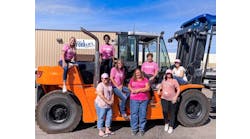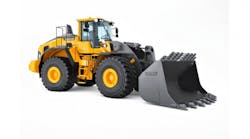Every year, the government releases the numbers. Every year, the numbers reveal a disturbing pattern in the equipment rental industry.
A rental center employee is more likely to be injured at work than the average U.S. employee.
Certainly, some explanation lies in the nature of the work. Obviously, an equipment rental center is going to have more on-the-job injuries than, say, an accounting firm. But it is somewhat disconcerting to discover that, according to the latest U.S. Bureau of Labor Statistics report, rental center personnel are more likely to suffer an occupational injury than employees working on an off-shore oil rig, in a paper mill or at a copper mine.
Again, part of the reason is the nature of the equipment rental business. The work environment at, say, an oil rig is, for the most part, static. That is, personnel generally work in the same environment every day for 50 weeks a year. Often, any given eight-hour shift involves the same type of work at the same workstation as the one before it and the one that will come tomorrow.
Compare that to the eight- or, more likely, 10-hour day of a rental center delivery driver, whose work environment can range from the rental yard to the road to a customer's jobsite in less than 30 minutes. Or consider a rental center mechanic, whose daily workload might find him repairing the steering mechanism in a scissorlift in the morning and putting a new hydraulic pump into a skid-steer loader in the afternoon.
But while a dynamic, ever-changing work environment has something to do with rental centers' higher incidence rates, a major contributing factor is the industry itself. According to experts at several rental companies with well-regarded safety programs, the industry, as a whole, is not focusing enough on accident prevention for its own employees.
"In general, the industry does a great job focusing on external safety," says John Malone, senior director of corporate business services at American Equipment, Greenville, S.C. "Customer safety is admittedly very important. But internally, [the industry] appears committed to employee safety more in principle than in practice."
What doesn't work Creating a comprehensive safety program that works is not easy. If it were, the number of injury accidents sustained by rental center employees each year would be much lower.
By law, all rental centers are required to comply with OSHA standards and regulations. However, there is nothing - no laws, no industry mandates - requiring anything beyond that, which explains how a fair number of safety programs at rental centers consist of a catchy slogan, a contest, a once-a-quarter meeting with employees and not much else.
While contests and meetings can help lower the number of accidents when combined with more active training, experts say they are destined for failure if they are not complemented by hands-on demonstrations and workshops.
Contests, such as the popular "safety bingo" games many firms offer, help to keep safety on employees' minds on a daily basis. But they can also have decidedly negative side effects, such as when employees on the same safety team pressure a team member not to report what they consider a "minor" injury or accident in order to stay in the running for the prize.
Meetings at which the president of the company pays five minutes of lip service to safety, plops a 50-minute general safety video into the VCR and leaves the room have very predictable endings. Moments after the boss exits, someone gets up and turns the channel on the TV, allowing the entire room to enjoy a re-run of Sanford and Son. For obvious reasons, Fred Sanford is not an OSHA-approved safety trainer.
"Companies can spend $10,000 to buy a bunch of videos, but if employees are falling asleep when the videos are played or there is no question-and-answer feedback after the videos have played, accidents will continue to occur with the same frequency as before at that company," says Jim Guarino, division safety manager at Park Ridge, N.J.-based Hertz Equipment Rental Corp. "And then you will have the executives at the company spending a lot more money to try to figure out why the $10,000 videos didn't get them anywhere."
"Films, handouts and lectures are good supplemental instruction," says Terry Osmond, general manager of one-location Quality Equipment Rentals, Inglewood, Calif. "And we've had good success with incentive programs, such as 'safety bingo.' But safety programs that have hands-on workshops or demonstrations where direct cause-and-effect relationships are observed seem most effective."
So what is a rental center owner or manager to do?
Start by looking in the mirror. Experts contend that management commitment is the most important factor that separates successful safety programs from ineffective ones.
Executives who spout safety cliches found in brochures get employees who do the same, not employees who feel accountable for their company's safety record and empowered to suggest change when procedures are not working.
"Any safety program must have the full commitment of upper management," says Angela MacKinnon, safety director at Equipco Rentals & Sales, a division of Evanston, Ill.-based National Equipment Services. "At our company, commitment filters down to supervisors, who provide an example for employees to follow."
Says American Equipment's Malone: "When a manager walks out to the shop and says, 'When are you going to get the machine delivered?' and makes no comment on safety first, then your safety program isn't going very far."
What works Management commitment is only one common theme that links successful safety programs. RER asked several of the industry's foremost safety experts to list the issues they would tackle first if they were tuning up a program. All agreed that management commitment and communication are top priorities. While they differed on some specific items, there was general agreement on the following themes:
* Survey employees and review any existing policies. Determine the level of safety knowledge among employees. Surveying truck drivers, mechanics and counter personnel can bring to light risks that were previously overlooked by management.
According to Equipco's MacKinnon, a survey is likely to inspire changes that can be made with relatively little effort, such as updating signs, painting safety lines, organizing chemical inventories and ordering new protective equipment.
* Train, train and train again. Start with upper management, because if the top brass don't know how the program works and why it is important, they can't communicate it. Then train employees in safe work practices, paying particular attention to branch managers.
"The backbone of any safety program is the branch manager," says HERC's Guarino. Branch managers are top management's most direct link to employees when it comes to most things, but especially with safety, he says.
* Establish consistent reporting practices. If a company doesn't establish a method to consistently report accident data, there is less of a chance of discovering trends.
"The easiest accident to prevent is the one that keeps occurring again and again, because you can discover the cause of the accident and design safeguards to prevent it from happening again," says Phil Kelling, president of ARA Insurance Services, Kansas City, Mo., and a member of the American Society of Safety Engineers.
* Market safety. While it is mandatory that employees buy into any effort, it helps to have customers on board as well. Customer awareness leads to fewer end-user accidents and can also serve to drum up business.
"Our larger customers in the industrial sector demand that we perform when it comes to safety," says Grace Crickette, who, as vice president of risk management for Greenwich, Conn.-based United Rentals, oversees safety at more than 500 rental centers in the United States and Canada. "If we were unable to evidence an excellent safety record and provide a quality safety program, [our salespeople] would not get their feet in the door."
* Control paperwork. This is the computer age, and there's no reason not to go digital with most, if not all, documentation. Off-the-shelf spreadsheet programs can keep accident data; safety software packages selling for as little as $300 not only keep and analyze data, but can tell a manager when an employee is due for a training update. Of course, the usual computer caveat is applicable: Regularly back up your data and store copies offsite.
* Revise the program. Reinventing and improving the effort reinvigorates employees as well as those providing the training. "If you stand still and don't change, you won't be effective for very long," says Crickette. "While we generally keep the core of our program intact, we are being innovative."
Examples of such innovation include United's intranet system, which allows managers to access information and records of safety meetings and inspections. Through the same Web-based system, Crickette says all United employees can access current safety training guidelines or procedures.
Bottom-line benefit Safety professionals are fond of saying there is no such thing as a minor accident. The reasoning is simple: The residual effects of any accident go far beyond one employee, one piece of equipment or one customer.
There are many obvious issues to consider with employee accidents, not the least of which is employees' health and well-being. An effective safety program keeps employees healthy and on the job, thereby increasing productivity, boosting morale and creating less turnover.
A quality safety program also feeds the bottom line by lowering insurance costs, reducing paperwork and decreasing exposure to costly lawsuits filed by customers. Because well-trained employees provide better customer service and instruction, the odds are less likely that a customer will plow a rented backhoe into a support beam and then sue the rental center.
The liability issue alone should be enough to motivate most rental center owners, who face a different legal burden than standard retail outlets. According to Kelling of ARA Insurance Services, a retail store can send product liability back to a manufacturer unless it does one of the following:
* Repackages the product, including painting or affixing stickers.
* Repairs or maintains the product.
* Gives instructions on how to use the product.
Of course, any good rental center does all three, leading to increased liability.
Says United's Crickette: "We are the middlemen. The manufacturer is responsible for the product design and the quality of the equipment provided. The customer is responsible for the proper use of equipment. If an accident occurs, the manufacturer is likely to be sued for product liability and the customer [may be] sued for negligence. In all probability, the equipment rental company will be sued for both."
Real risk management By its very nature, equipment rental is a risky business. A truck driver who loads equipment off and on a lowboy trailer is exposed to more risk in a day than many Americans face on the job in a month. And rental center customers are often engaged in high-risk industries, such as construction and manufacturing.
"All businesses have intrinsic risk," says Osmond of Quality Equipment Rentals. "The nature of the rental industry is such that its exposure to risk is greater than most other industries. Your employees and customers are exposed to a great variety of machinery that can be quite dangerous if not handled properly. Add to this the fact that many customers are first-time users, and that risk becomes compounded."
The good news is that there has been a small improvement of late. Equipment rental centers averaged 7 nonfatal injuries per 100 employees in 1997 versus 7.6 injuries per 100 employees in 1995, according to the Bureau of Labor Statistics.
Nevertheless, is that any excuse for the fact that, year after year, the industry's incidence rate is higher than the average for all U.S. industries?
Not when the risks of running a rental center are so well-documented.
Not when many rental centers with successful safety programs are willing to share knowledge with their competitors.
"The industry's safety performance can be significantly improved," says American's Malone. "I heard a railroad executive once say, 'Railroading isn't dangerous, it is just unforgiving.' Our business is similar. If you avoid mistakes, you can remain safe. I believe that the risk in our industry can be managed, and we can outperform the average for all industries."
In other words, there is no excuse.
Equipment rental companies averaged 7 nonfatal injury accidents per 100 full-time employees in 1997, according to the U.S. Bureau of Labor Statistics. How does your rental center measure up?
To find out, plug your numbers into the equation below:
(N/H) x 200,000 = Your company's incidence rate
N equals the number of injuries your company sustained during the year.
H equals the number of employee hours worked during the year.
200,000 equals the number of hours 100 full-time employees work in a year (in other words, 100 workers x 40 hours x 50 weeks).


